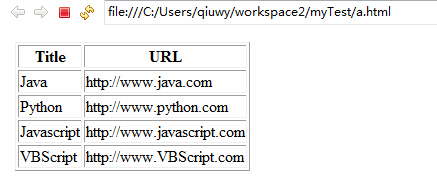写自动化测试时,一个很重要的任务就是生成漂亮的测试报告。
1.用junit或testNg时,可以用ant辅助生成html格式:
<target name="report" depends="run">
<junitreport todir="${report.dir}">
<fileset dir="${report.dir}">
<include name="TEST-*.xml" />
</fileset>
<report format="noframes" todir="${report.dir}" />
</junitreport>
<echo message="Finished running tests." />
</target>
具体查看我的另外一篇博客:项目构建工具ant的使用
2.用maven管理测试代码时,可以用maven自带的插件生成html格式的测试报告:
具体查看博客:用插件maven-surefire-report-plugin生成html格式测试报告
3.用xslt格式化xml,生成html格式文件
(1)简要介绍XSLT:
XSLT是一种用于将XML文档转换任意文本的描述语言,XSLT中的T代表英语中的“转换”(Transformation)。
Xslt使用xpath来在xml文件中定位元素
(2)准备xml文件
比如说是a.xml文件:
<?xml version="1.0"?>
<howto>
<topic>
<title>Java</title>
<url>http://www.java.com</url>
</topic>
<topic>
<title>Python</title>
<url>http://www.python.com</url>
</topic>
<topic>
<title>Javascript</title>
<url>http://www.javascript.com</url>
</topic>
<topic>
<title>VBScript</title>
<url>http://www.VBScript.com</url>
</topic>
</howto>
(3)准备xsl文件,a.xsl:
<?xml version="1.0"?>
<xsl:stylesheet xmlns:xsl="http://www.w3.org/1999/XSL/Transform" version="1.0">
<xsl:template match="/">
<html>
<head><title>Real's HowTo</title></head>
<body>
<table border="1">
<tr>
<th>Title</th>
<th>URL</th>
</tr>
<xsl:for-each select="howto/topic">
<tr>
<td><xsl:value-of select="title"/></td>
<td><xsl:value-of select="url"/></td>
</tr>
</xsl:for-each>
</table>
</body></html>
</xsl:template>
</xsl:stylesheet>
解释:
由于 XSL 样式表本身也是一个 XML 文档,因此它总是由 XML 声明起始:<?xml version="1.0"?>
把文档声明为 XSL 样式表的根元素是 <xsl:stylesheet> 或 <xsl:transform>,如需访问 XSLT 的元素、属性以及特性,我们必须在文档顶端声明 XSLT 命名空间。
xmlns:xsl="http://www.w3.org/1999/XSL/Transform" 指向了官方的 W3C XSLT 命名空间。如果您使用此命名空间,就必须包含属性 version="1.0"。
<xsl:template> 元素用于构建模板,而 match="/" 属性则把此模板与 XML 源文档的根相联系
<xsl:value-of select=“howto/topic”/ > 元素用于提取某个选定节点的值,select后面是xpath用来定位xml
<xsl:for-each> 元素允许您在 XSLT 中进行循环。
(4).准备java转换代码
package com.qiuwy.mavenDemo.myTest;
import javax.xml.transform.*;
import javax.xml.transform.stream.StreamResult;
import javax.xml.transform.stream.StreamSource;
import java.io.*;
public class XmlToHtml {
public static void main(String[] args) {
String src="a.xml";
String dest="a.html";
String xslt="a.xsl";
File src2=new File(src);
File dest2=new File(dest);
File xslt2=new File(xslt);
Source srcSource=new StreamSource(src2);
Result destResult =new StreamResult(dest2);
Source xsltSource=new StreamSource(xslt2);
try {
TransformerFactory tFactory = TransformerFactory.newInstance();
Transformer transformer = tFactory.newTransformer(xsltSource);
transformer.transform(srcSource, destResult);
} catch (Exception e) {
e.printStackTrace();
}
}
}
(5)执行java代码后,生成a.html文件

以上只是一个简单的例子,实际运用过程中还是要复杂很多